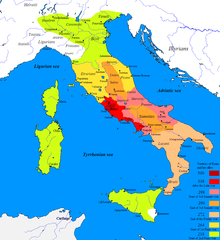| Millennium: | 1st millennium BC |
|---|---|
| Centuries: | |
| Decades: | |
| Years: |
| 264 BC by topic |
| Politics |
|---|
| Categories |
| Gregorian calendar | 264 BC CCLXIV BC |
| Ab urbe condita | 490 |
| Ancient Egypt era | XXXIII dynasty, 60 |
| - Pharaoh | Ptolemy II Philadelphus, 20 |
| Ancient Greek era | 129th Olympiad (victor)¹ |
| Assyrian calendar | 4487 |
| Balinese saka calendar | N/A |
| Bengali calendar | −856 |
| Berber calendar | 687 |
| Buddhist calendar | 281 |
| Burmese calendar | −901 |
| Byzantine calendar | 5245–5246 |
| Chinese calendar | 丙申年 (Fire Monkey) 2434 or 2227 — to — 丁酉年 (Fire Rooster) 2435 or 2228 |
| Coptic calendar | −547 – −546 |
| Discordian calendar | 903 |
| Ethiopian calendar | −271 – −270 |
| Hebrew calendar | 3497–3498 |
| Hindu calendars | |
| - Vikram Samvat | −207 – −206 |
| - Shaka Samvat | N/A |
| - Kali Yuga | 2837–2838 |
| Holocene calendar | 9737 |
| Iranian calendar | 885 BP – 884 BP |
| Islamic calendar | 912 BH – 911 BH |
| Javanese calendar | N/A |
| Julian calendar | N/A |
| Korean calendar | 2070 |
| Minguo calendar | 2175 before ROC 民前2175年 |
| Nanakshahi calendar | −1731 |
| Seleucid era | 48/49 AG |
| Thai solar calendar | 279–280 |
| Tibetan calendar | 阳火猴年 (male Fire-Monkey) −137 or −518 or −1290 — to — 阴火鸡年 (female Fire-Rooster) −136 or −517 or −1289 |

Year 264 BC was a year of the pre-Julian Roman calendar. At the time it was known as the Year of the Consulship of Caudex and Flaccus (or, less frequently, year 490 Ab urbe condita). The denomination 264 BC for this year has been used since the early medieval period, when the Anno Domini calendar era became the prevalent method in Europe for naming years.